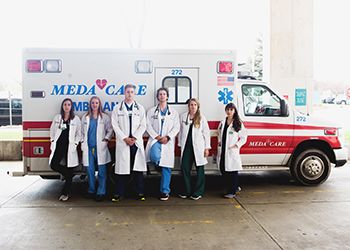Giving Feedback Effectively
- Providing feedback is professional responsibility as a preceptor
- Create a stimulating environment where feedback is encouraged and can be successful
- Be specific!
- Focus on observed events/issues
- Discuss specific behaviors and suggestions for improvement
- Encourage student to provide thoughts on their own performance and areas for improvement
- Feedback should be 2-way street!
- Overcome barriers to successful delivery of feedback
- Be clear with goals and expectations up front
- Make feedback regular part of each day
- Address concerning behaviors/issues ASAP and provide meaningful solutions
- Focus feedback on your area of expertise
- Sandwich technique for delivery of negative feedback
- Objective and constructive sharing of observations, suggestions, and recommendations with a student
- Constructive feedback helps student identify areas where they need to make changes and improvements
- Goal of feedback is to change bad or poor behavior, reinforce good behavior, and improve skills
Good feedback is not
- Non-specific comments “Read more”: this does not help the student identify specific areas of knowledge deficits
- Harsh criticism Feedback should be constructive for it to be impactful
- Formal assessment Feedback can and should be given throughout the student’s rotation, not just at the end as part of a formal assessment
Why is feedback important?
- Professional responsibility to help students improve and grow during their rotation
- Allows the student to implement change and for you to accurately assess his/her willingness to respond to feedback
- Students often appreciate feedback and feel more engaged and valued during their rotations
How can you give effective feedback?
- Establish an environment where feedback is regularly dispensed and expected by the student
- Clearly define that you are giving feedback
- “I’d like to give you some feedback about …”
- Prepare student for negative feedback as necessary
- Warning shot
- “I’d like to give you some feedback about something that is a little concerning to me”
- Propose ideas for moving forward and making improvements
- “In the future I would like to see …”
- “Next time...”
- Ensure that the student has a clear understanding of your expectations and educational goals you have set for them
- When giving feedback, ensure that you do this in a timely manner
- Most impactful when given immediately after concerning event, not a week or two later
- Feedback should be given in private with minimal distractions when possible
- Base feedback on first hand observations and provide an example, do not base on hearsay
- Use non-judgmental language
- Focus on the action and consequences rather than accusing the student of poor judgement
- Be specific and give examples
- “Your work-up and management of patient x was problematic because…”
- Reinforce positive behaviors
- “Your interactions with the patients and their families today was exemplary”
- Address behaviors/concerns since the last feedback
- Do NOT perseverate on old concerns or previous mistakes unless they continue to be problematic
- Only address a few behaviors/concerns at one time
- Attempting to address multiple issues will overwhelm the student and is not effective in prompting change on his/her behalf
- Discuss only behaviors/concerns which can be modified and improved
- Giving feedback on fundamental personality characteristics which are not modifiable is not productive and can lead to feelings of resentment
- When possible, have the student self-assess and identify areas they feel they can improve and/or problematic decisions they have made
- You can build off this and offer suggestions for improvement
- At end of feedback session, be sure to summarize and review next steps
- To improve, you will do x and x by x time
- Arrange for follow-up as necessary
- Build in time to review progress either at a set time or mid-way through the rotation
- “Let’s come back to this again in 1 week to discuss your progress in implementing these changes we have just discussed”
What are some barriers to giving effective feedback?
- Uncomfortable with confrontation
- Sandwich technique
- Start and end with positive feedback, negative feedback given between positive comments
- Mentally rehearse the discussion until comfortable discussing with the student
- Speak to Marquette PA Program representative for further insight
- Belief that things will improve on their own
- Student has a “difficult” personality
- Focus on the behavior, not the person
- “Your style of interaction was taken offensively by the listener, which I’m sure was not your intention” vs “You’re being rude”
- Ask the student to self-assess to see if they understand the issue
- Reach out to the PA program if you have serious concerns about a student’s personality and ability to function at a professional level
- Goal is to improve behaviors and skills, not to change basic personality characteristics
- Angry/Sad/Defensive student
- Reframe the negative feedback
- Encourage that change will result in a positive outcome for the student in their future interactions with patients/staff/etc.
- Give the student time to process the information and re-address later
- Keep the conversation on track and specific
- Focus on specific areas of change and expected results
- Timing
- Make feedback a regular and expected occurrence
- Schedule specific day/time if necessary
- Address issues when they arise and are fresh, often only takes a few minutes of time and impact can be significant
- Keep feedback brief by focusing on 1-2 specific behaviors/events and what the student can do differently next time
- Uncertain about own knowledge base
- Focus feedback on what you are comfortable with in medical knowledge, communication, professionalism, and practice management
- Model behavior for student
- Look up information together
- Encourage student to look up independently and meet at future designated time to review together
- Get help from consultant service
- Demonstrates how to handle a complicated situation when you are unsure of what to do




